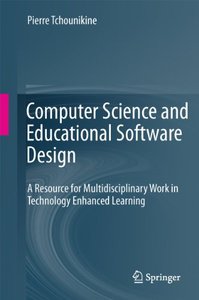Computer Science and Educational Software DesignA Resource for Multidisciplinary Work in Technology Enhanced Learning
|

|
 Diese Seite wurde seit 3 Jahren inhaltlich nicht mehr aktualisiert.
Unter Umständen ist sie nicht mehr aktuell.
Diese Seite wurde seit 3 Jahren inhaltlich nicht mehr aktualisiert.
Unter Umständen ist sie nicht mehr aktuell.
 Zusammenfassungen
Zusammenfassungen
 Truly interdisciplinary approach to combine the viewpoints of computer scientists and educational actors
Truly interdisciplinary approach to combine the viewpoints of computer scientists and educational actorsProvides practical and context-related hints on how to deal with the peculiarities of educational software design and development
Complemented by several examples illustrating issues and propositions
Based on the author´s more than 20 years´ experience in projects on technology-enhanced learning
Developing educational software requires thinking, problematizing, representing, modeling, implementing and analyzing pedagogical objectives and issues, as well as conceptual models and software architectures. Computer scientists face the difficulty of understanding the particular issues and phenomena to be taken into account in educational software projects and of avoiding a naïve technocentered perspective. On the other hand, actors with backgrounds in human or social sciences face the difficulty of understanding software design and implementation issues, and how computer scientists engage in these tasks.
Tchounikine argues that these difficulties cannot be solved by building a kind of 'general theory†or 'general engineering methodology†to be adopted by all actors for all projects: educational software projects may correspond to very different realities, and may be conducted within very different perspectives and with very different matters of concern. Thus the issue of understanding each others´ perspectives and elaborating some common ground is to be considered in context, within the considered project or perspective. To this end, he provides the reader with a framework and means for actively taking into account the relationships between pedagogical settings and software, and for working together in a multidisciplinary way to develop educational software.
His book is for actors engaged in research or development projects which require inventing, designing, adapting, implementing or analyzing educational software. The core audience is Master´s and PhD students, researchers and engineers from computer science or human and social sciences (e.g., education, psychology, pedagogy, philosophy, communications or sociology) interested in the issues raised by educational software design and analysis and in the variety of perspectives that may be adopted. In addition, it is also of interest for teachers engaged in, for example, ICT-based innovations.
 Dieses Buch erwähnt ...
Dieses Buch erwähnt ...
 Begriffe KB IB clear |  Denken Denken thinking
, Informatikcomputer science
, thinking
, Informatikcomputer science
,  Innovation Innovation innovation
, innovation
,  Lernen Lernen learning
, learning
,  Problemlösefähigkeit Problemlösefähigkeit problem solving skills
, Zone of Proximal Development problem solving skills
, Zone of Proximal Development
|
 Dieses Buch erwähnt vermutlich nicht ...
Dieses Buch erwähnt vermutlich nicht ... 
 Nicht erwähnte Begriffe | Informatik-Didaktik, Informatik-Unterricht (Fachinformatik) |
 Volltext dieses Dokuments
Volltext dieses Dokuments
 Bibliographisches
Bibliographisches 
| Titel | Format | Bez. | Aufl. | Jahr | ISBN | ||||||
| Computer Science and Educational Software Design | E | - | - | 1 | 3642200028 |  |
 |
 |
 |
 Beat und dieses Buch
Beat und dieses Buch
Beat hat dieses Buch während seiner Zeit am Institut für Medien und Schule (IMS) ins Biblionetz aufgenommen. Beat besitzt kein physisches, aber ein digitales Exemplar. (das er aber aus Urheberrechtsgründen nicht einfach weitergeben darf). Aufgrund der wenigen Einträge im Biblionetz scheint er es nicht wirklich gelesen zu haben. Es gibt bisher auch nur wenige Objekte im Biblionetz, die dieses Werk zitieren.











 , 860 kByte)
, 860 kByte)  Biblionetz-History
Biblionetz-History